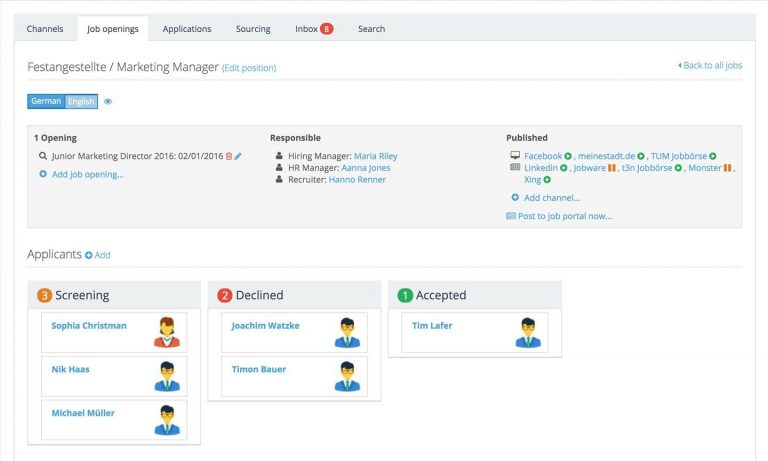13. January 2022
How we made the hiring process for a crucial role 40% faster

It's no secret that the hiring process has become pretty challenging since the onset of the pandemic, but especially so following the ‘Great Reshuffle’. In the UK for example, the number of company vacancies reached their highest point in November 2021 since records began. We are facing what some commentators have called an "unparalleled labour market crisis".
Get the inside track – take a look at our HR study on the post-pandemic talent drain.
Given the difficult landscape, it’s no surprise that companies were struggling to fill positions as quickly as they needed. Personio was no exception. Senior Talent Acquisition Manager, Kálmán Györy was on the hunt for engineering managers to lead several new teams (notoriously difficult roles to hire for), and the hiring process had been slower than expected.
Although the Engineering Talent Acquisition Team needed their hires to be in the double digits, by June 2021 they had only secured five new engineering managers. He realised they would need to rapidly restructure their hiring process. The first step? A deep dive into exactly what could be causing the slower results.
What can cause the hiring process to be slow?
1. There are communication gaps
Firstly, these were very technical roles that needed a lot of input, shares Kálmán: “We didn’t have complete alignment on what to expect from these candidates, which led to much back and forth between us and hiring managers in the middle of the process.” This was because the Talent Acquisition team was not always sure if the candidate matched the requirements.
2. There’s not enough time available
At the time, both the Talent Acquisition team and the hiring managers were also overloaded with interviews. As a result, sometimes they would not be able to return their candidate evaluations within the requested 24 hours, which further delayed the hiring process.
3. There are too many stages (along with big gaps)
At the time, Personio’s hiring process for this specific role consisted of 1) an HR interview, 2) a team lead interview, 3) a technical case study, 4) a management case study, and 5) a final stage consisting of a peer, value, and founder interview. The management case studies came in the form of take-home assignments for which candidates were given 7-10 days to complete. As you can imagine, this created significant delays in what was already a competitive talent market.
4. Self-inflicted rules delay offers being made
Finally, there was an interview panel after each process for approvals (“even when the decision was clearly ‘go’”, says Kálmán). As a consequence, waiting times for these could be quite high as they depended on multiple people’s availability. The result was that hiring and much-needed growth on the team was much slower than planned.
Create a great candidate experience

Organise applications, plan interviews and quickly evaluate candidates. Manage your entire hiring process with one tool with Personio.
Unlock Smoother HiringWhat can be done internally to fast-track recruitment?
1. Empower recruiters with the right information
In this case, Personio was hiring for a very specific role, with very specific skills, shares Kálmán. This required frequent lines of communication between hiring managers and the Talent Acquisition team:
“Recruiters required an in-depth understanding of what engineering managers needed to bring to the table. This required recruiters to have a good connection with the business team and regular communication when requirements changed.”
For example, after introducing a Lead Engineer role who tended to look after very technical work on the team, it changed the expectations the Talent Acquisition team had for candidates. They realised it would be more about people management and less about technical leadership.
2. Install a specialised ‘task force’
Is one of your roles quite different from another? For example, the Engineering Talent Acquisition Team quickly realised that was the case for his team as they differentiated between roles needed for Platform Engineering and Product Engineering. Therefore it would be important “to bring in people from both backgrounds in order to understand each focus’ specific needs and challenges.”
To combat this, the team set up a task force that included two Engineering Directors (recent joiners, who could bring fresh ideas and experiences from other companies), one Senior Engineering Manager (with Personio since 2017, with background on previous challenges), and one representative from Talent Acquisition (to monitor candidate experience and set them up for success).
3. Create a clear roadmap for changes
How do you make sure that your hiring process can be improved, ASAP? Be rigorous, says Kálmán: “We set up a project roadmap containing all the steps required to reinvent our process. In order to move fast, we established weekly meetings and a clear deadline.”
Next, the team established what could be done to benefit overall candidate experience and ultimately to ensure they could recruit great talent, quickly.
How to streamline the hiring process for candidates
1. Always be mindful of a candidate’s time
Make no mistake – if you are hiring for a specialised position such as Engineering Manager, “be aware of the fact that most candidates are in more than just one interviewing process at the same time,” says Kálmán. Because of this, “having a flexible but well-structured process is key.”
In order to ensure that candidates’ time was being respected, the team did the following:
Gave applicants flexibility around their final virtual on-site day. This could be split into two parts (cases on day one, interviews on day two), or held on the same day.
Committed to giving candidates feedback on each stage within 1-3 working days. This way, hiring managers also showed a higher commitment to filling in their evaluation on time.
Communicated to candidates that the (now reduced) hiring process only contained only three steps – HR interview, team lead interview, and the virtual on-site-day.
2. Swap take-home tests for real-time discussions
“In general, we are seeing a trend to move away from take-home assignments as standard, and towards more flexibility around candidates showcasing their skills”, says Kálmán. Controversial as this may be, he reminds that if you are looking for experienced candidates, they will often have commitments after work (such as family) and are simply not able to do them.
To accelerate the hiring process, the team instead replaced them with a verbal, in-interview test. To do this, the engineering representatives came up with a document that clearly outlined:
Expectations to the candidate
A clear scenario they would need to address
A list of areas and questions to follow during case interviews
To fully prepare candidates, they would receive detailed expectations and the specific situation they will work on during the verbal case five days prior to the interview, along with clear guidelines of what to prepare and what not to prepare (the team had at times, received 40-slide presentations). “This gives the candidates the chance to familiarise themselves with the task and to ask questions.”
Then, they began to test their experiment: “After only four weeks we saw that our process changes had a significant positive impact on some core KPIs like process speed and candidate experience” says Kálmán.
3. Leave time in each interview for questions
“The recruitment process is a two-sided process. You are interviewing the candidate but the candidate is also interviewing you/the company,” shares Kálmán. “Give the candidate the chance to raise questions after each interview, do not rush through.”
4. Schedule a call before the final round
This is such an important best practice for ensuring your candidates perform well and are committed to your company at this late stage: As standard, the team installed a 15-minute call after the team lead interview to explain in detail what to expect of each stage of the virtual on-site day.
This soon became an essential time to connect with candidates: “Often availability and/or salary expectations have changed or other questions came up after the team lead interview.” But it had a less obvious benefit too: “By having another check-in, we were also able to increase candidates’ commitment to their application, and decrease questions after the last interview, saving us additional time.”
5. Ensure candidates get quick responses
In one recent instance, Kálmán received 35 team-specific questions after they had made an offer to the candidate. Fortunately, the hiring manager provided detailed answers the next day, and the candidate was pleasantly surprised by the speedy response:
“Especially in the later stages of the hiring process, it’s important to act fast in these situations. You have invested a lot of time and resources into the candidates, you certainly don’t want to lose them due to the wrong prioritisation.”
While it may not be realistic for hiring managers to always have time to prepare 35 answers, it may be worthwhile for your talent teams to prepare some frequently asked questions (such as your work from home policy, or your employee benefits). This way, your recruiters stay one step ahead and your candidates can always receive quick, consistent answers.
6. Cut out any repetitive assessments
In a post that went viral software engineer Mike Conley described pulling out of an interview after it emerged he would need to do 10 rounds of interviews. According to the BBC, long processes like these are causing people to lose patience. Though your company’s selection process may not be as long, chances are there are definitely areas you could trim from your hiring process.
For this, “identify what purpose each interview step is serving, and then check if there are any areas which are getting evaluated more than once” advises Kálmán. “If there are interviews that are strongly overlapping and candidates have shared that feedback, that interview stage might be redundant.“
Another way to combat this is to identify any multiple-stage interviews which can be combined into one interview. Or, if you are hitting capacity issues for interviews done by more than one person, see if it might be better to assign only one interviewer to the interview.
Your current workforce is a great source for insights here into your hiring process and the candidate experience it creates. Think about building an anonymous survey in which they can rank each step, share if they think any didn’t feel that worthwhile, or provide suggestions for improvement.
How to use employer brand to fast-track recruitment
1. Think about work/life balance benefits
So, what are Kálmán’s predictions for 2023? “Specifically in engineering hiring we will see a high demand for particular talent.” How to get it? “Be internally aligned, fast, authentic, and understand that candidates have multiple options.”
Your company will also need to offer a high level of flexibility, such as working from home. “Align with your business on how flexible your company working model is and can be in the future.”
2. Build team-specific brands with exciting features
Finally, you’ll want to create what the team refers to as a ‘candidate brand’. Kálmán explains that “especially in tech recruiting, candidates are not only checking the company itself, but its product and engineering brand.” To do this, consider elements such as:
Is your tech stack interesting?
Are your employees speaking at big conferences?
Do we have an active tech blog?
Is the company facing interesting technical challenges?
Assure you formulate your employer value proposition in a way that assures candidates that they are joining your company for the right reasons: “Establishing a product and engineering brand not only helps to generate applications, but it can also have a positive impact on the commitment candidates show in their application processes.”
Building a great employer brand is no easy feat, but if the results this team created are anything to go by, it will be well worth the investment.

Hannah Popham
Hannah is a Senior Content Marketing Manager at Personio. She loves writing about the ever-changing ways that we work and how they intersect with our lives outside work.

